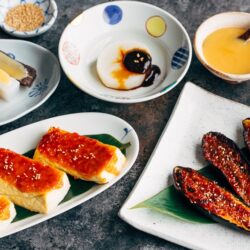
Miso Dengaku (Tofu, Eggplant, Daikon & Konnyaku)
Slathered in sweet & savory miso glaze, Miso Dengaku with tofu, eggplant, daikon, or konnyaku has been enjoyed in Japan since 1500's.
Ingredients
Miso Dengaku Sauce (enough for 1–2 types of ingredients below)
- 2 Tbsp sake
- 2 Tbsp mirin
- 4 Tbsp miso (traditionally the Japanese use red miso, but any miso is fine)
- 2 Tbsp sugar (use 3 Tbsp instead of 2 Tbsp if you use hatcho miso)
★ Tofu & Eggplant Dengaku
- 1 medium-firm tofu (momen dofu) (14 oz, 397 g)
- 3 Japanese or Chinese eggplants (or use 1 globe eggplant)
- 1 Tbsp neutral oil
- 1 tsp toasted white sesame seeds
★ Daikon Dengaku
- 3 inches daikon radish (use the top green part of the daikon, which is sweeter and less bitter)
- 1 piece kombu (dried kelp) (5 g; 2 x 2 inches, 5 x 5 cm per piece)
- ½ tsp toasted white sesame seeds
★ Konnyaku Dengaku
- 2 blocks konnyaku (konjac) (18 oz, 510 g)
Instructions
- Before You Start…Please note that this recipe requires 30 minutes of tofu pressing time. Gather all the ingredients.
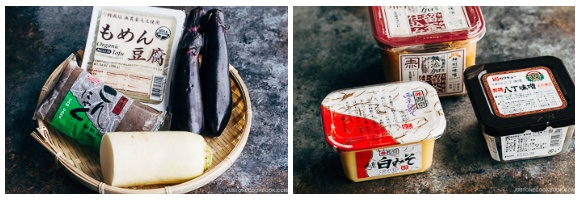
Miso Dengaku Sauce
- Combine 2 Tbsp sake, 2 Tbsp mirin, 4 Tbsp miso, and 2 Tbsp sugar in a saucepan. Mix well to combine and then bring to a gentle simmer over the lowest heat. Stir constantly and cook for 2–3 minutes. Make sure the miso doesn’t burn. When the miso has thickened, it’s ready to use. To Store: You can put the miso in an airtight container and store the refrigerator for up to 3–4 weeks.
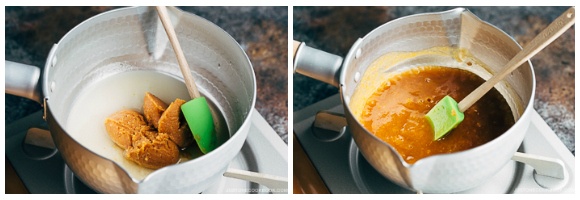
- Use the miso glaze to slather on the foods you prepare below.
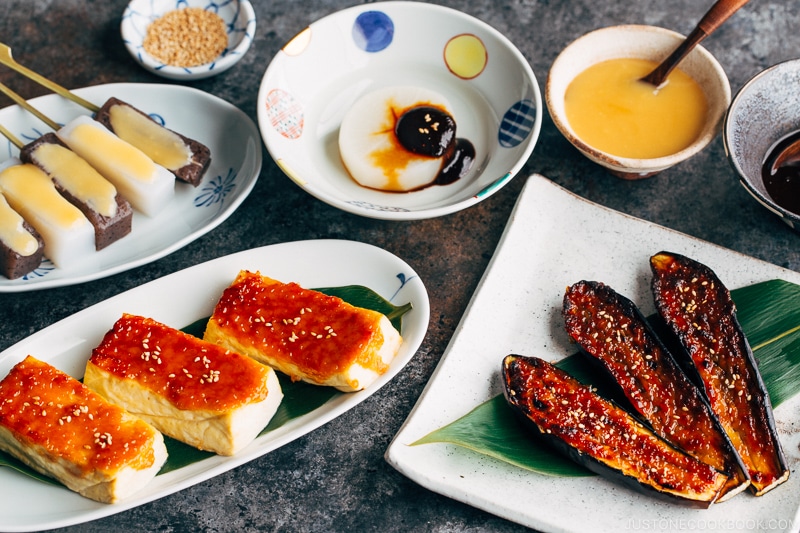
★ Tofu & Eggplant Dengaku
- Preheat the oven to 400ºF (200ºC). For a convection oven, reduce the cooking temperature by 25ºF (15ºC). Wrap 1 medium-firm tofu (momen dofu) with 2 sheets of paper towel and press the tofu between two plates for 30 minutes. Alternatively, you can microwave paper towel-wrapped tofu for 60–90 seconds to dehydrate. Once the tofu is dehydrated, cut it into small bite-size (any shape is ok), and the thickness should be about ¾ inch (1.5 cm).
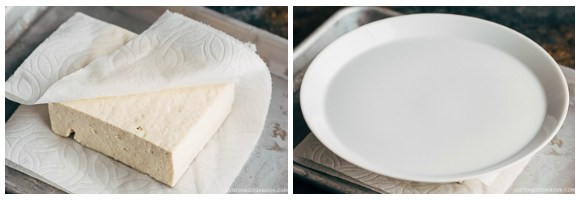
- Cut 3 Japanese or Chinese eggplants in half lengthwise and score the cut surface in a crisscross pattern. This will help the eggplant absorb more flavor. Immediately soak in water to prevent the eggplants from changing color and to remove the bitter taste. Drain and dry with a paper towel.
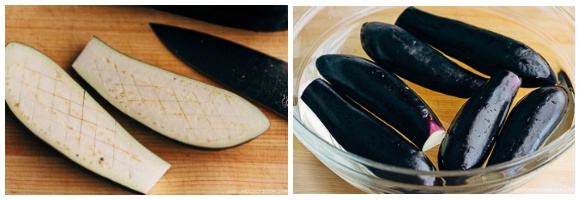
- Place the tofu and eggplants (skin side down) on a rimmed baking sheet lined with parchment paper or a silicone baking sheet. With a brush, apply 1 Tbsp neutral oil on top and bottom of tofu and eggplants. Bake at 400ºF (200ºC) for 30 minutes, or until the eggplant is tender. Remove the baking sheet from the oven. Adjust the oven rack 6 inches from the heating element and preheat the broiler for 3 minutes. Meanwhile, carefully spoon some of the Miso Dengaku Sauce onto your tofu and eggplants and spread evenly. Broil for 3–4 minutes, or until the top has a nice char and caramelization. Transfer to a serving platter, sprinkle with 1 tsp toasted white sesame seeds, and serve immediately.
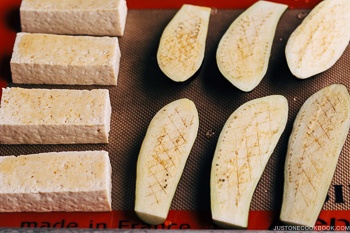
★ Daikon Dengaku
- Peel 3 inches daikon radish and cut it into ¾-inch (1.5- to 2-cm) rounds (or you can cut into a half-moon shape if the daikon is very big). Make a crisscross incision on one side in the center (just one side—this will be the bottom side when serving), which helps absorb the seasonings. We call this technique kakushi bocho.
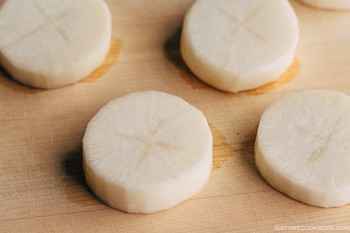
- Place the daikon in the pan and cover with water. Ideally, instead of water, you want to use the rice-soaked water (the first white water that you throw away while washing rice). It’ll help the daikon keep its pretty white color. Now, bring to a boil over high heat. Once boiling, cook on low heat for 20 minutes.
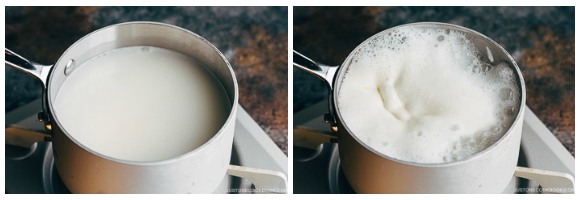
- Drain the rice-soaked water and put the daikon back in the pot. Cover the daikon with more water, add 1 piece kombu (dried kelp), and bring to a boil. Right before boiling, remove and discard the kombu. Lower the heat to simmer and cook daikon for another 20 minutes, or until a skewer pierces through smoothly. Turn off the heat and transfer to a serving dish. Pour a generous amount of Dengaku Miso and sprinkle ½ tsp toasted white sesame seeds on top. Serve warm.
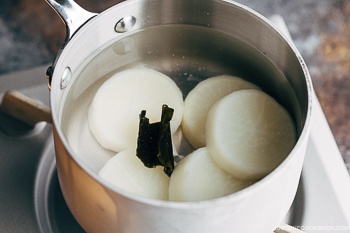
★ Konnyaku Dengaku
- Cut 2 blocks konnyaku (konjac) into bite-size pieces and gently score each piece with a crisscross pattern on the top.
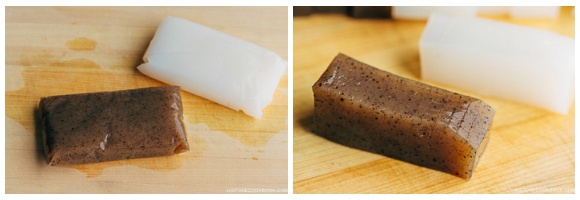
- Bring water in a medium saucepan to a boil and cook the konnyaku for 3 minutes. Drain and allow to cool a little bit, then insert a bamboo skewer in each piece. Slather a generous amount of Dengaku Miso on top and serve immediately.
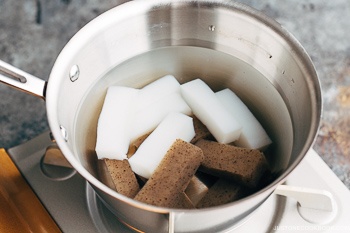
To Store
- You can keep the leftovers in an airtight container and store in the refrigerator for up to 3 days.
Nutrition
Calories: 250kcal, Carbohydrates: 25g, Protein: 13g, Fat: 10g, Saturated Fat: 4g, Polyunsaturated Fat: 4g, Monounsaturated Fat: 2g, Sodium: 647mg, Potassium: 487mg, Fiber: 8g, Sugar: 16g, Vitamin A: 54IU, Vitamin C: 9mg, Calcium: 164mg, Iron: 2mg